Part One: Melody
Focuses on single note soloing. Learn how to effortlessly solo through complex chord changes.
Free Jazz Guitar Lessons with Chris Standring
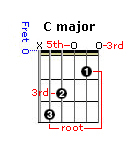
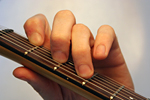
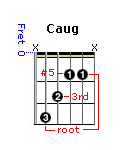
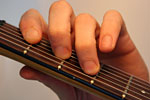
Notice that in the C augmented chord shape the top string has been muted with an "X". This is only for practical purposes. It is not easy to play the chord with the 3rd ringing on the top string. It is better to barre the two inner strings with your first finger and avoid or mute the top string altogether. Now let's have a look at a movable chord shape: Here is the parent major chord first, followed by the augmented chord. Notice where the degrees of the chord sit.
C
major

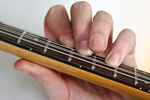
C aug

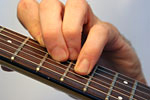
An augmented triad is made up of two major 3rds. For example in C major,
the distance between C and E is a major 3rd (or 5 frets) and the distance
between E and G# is also a major 3rd (5 frets). Then if you count another
major 3rd from the #5 upwards you get back to C again, the root. This
tells us (much like our diminished friend) that any note within that augmented
chord could also be a root note. If you move the whole augmented chord
up or down 5 frets you will see that all the notes of that chord exist
again, only the degrees of the chord are switched around. For example.
Take our C aug chord above and shift it up a major 3rd (5 frets) and you
get this:

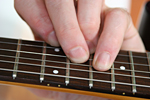
Move it down a major 3rd or 5 frets (from your original position) and
you get this:

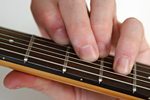
An augmented chord can therefore have 3 roots, or in other
words, the same chord can function as three different augmented chords.
For instance, the chord C augmented could also be named, E aug or G# aug.
In jazz, an augmented chord is more effectively visualized as part of
a dominant 7th chord. So for example, if we take a C dominant 7th chord
and add a sharpened fifth, we see an augmented triad at the top. The augmented
triad could be either C augmented, E augmented or G# augmented.
Free online jazz guitar lessons for beginners, intermediates and advanced.
Online jazz guitar instruction from recording artist Chris Standring
Join The Inside Track membership and get access to all Chris Standring's guitar instructional programs, all in one place.
It has been many years since the first edition of Play What You Hear (originally released in 2000). Now volume two is here with new ideas and concepts, complete with audio, video, traditional notation and TAB throughout. High resolution pdf available for printing the entire program. For intermediate and advanced players.
Focuses on single note soloing. Learn how to effortlessly solo through complex chord changes.
Focuses on chord melody. Learn new harmonic devices and understand chords in a whole new way.
Study Chris Standring's six recorded solos, transcribed with audio and high def video.
Copyright © PlayJazzGuitar.com - All Rights Reserved.